✅ Author Introduction: A Matlab simulation developer passionate about scientific research, skilled in data processing, modeling simulation, program design, complete code acquisition, paper reproduction, and scientific simulation.
🍎 Previous Review: Follow my personal homepage:Matlab Research Studio
🍊 Personal Motto: Investigate to gain knowledge, complete Matlab code and simulation consultation available via private message.
🔥 Content Introduction
With the increasing penetration of renewable energy, the operation of power systems faces unprecedented challenges. The output of intermittent power sources such as wind and solar energy is highly uncertain and fluctuating, significantly impacting the stable operation of power systems. To address these challenges, energy storage technology has gained widespread attention as a flexible and efficient solution. Energy storage systems can not only smooth the output of renewable energy but also participate in peak shaving and frequency regulation of power systems, improving operational efficiency and reliability. Therefore, research on energy storage peak shaving and frequency regulation models in power systems holds significant theoretical and engineering application value.
This article will delve into the construction and optimization of energy storage peak shaving and frequency regulation models, covering the basic principles of the models, modeling methods, optimization strategies, and application cases, aiming to provide theoretical guidance and technical support for the application of energy storage technology in power systems.
1. Application Value of Energy Storage Technology in Power Systems
Energy storage technology refers to the technology of storing electrical energy in some form and releasing it when needed. Based on the form of energy storage, energy storage technology can be divided into various types, including physical storage (such as pumped storage, compressed air energy storage, flywheel energy storage, etc.), chemical storage (such as battery storage, flow battery storage, etc.), and electromagnetic storage (such as superconducting storage, supercapacitor storage, etc.). Different types of energy storage technologies have different characteristics and are suitable for different application scenarios.
The application value of energy storage technology in power systems is reflected in the following aspects:
- Peak Shaving: Energy storage systems can store electrical energy during low demand periods and release it during peak demand periods, thereby reducing the peak-to-valley difference, improving the utilization of power equipment, and lowering generation costs.
- Smoothing Renewable Energy Output: Energy storage systems can smooth the output fluctuations of renewable energy sources such as wind and solar power, increasing the utilization of renewable energy and reducing dependence on traditional energy sources.
- Frequency Regulation: Energy storage systems can quickly respond to frequency changes in the power system, providing frequency regulation services to maintain frequency stability and improve the reliability of the power system.
- Voltage Support: Energy storage systems can provide voltage support for the power system, improving the voltage quality of the grid and enhancing supply reliability.
- Isolated Operation: In the event of a grid failure, energy storage systems can provide backup power to support the isolated operation of critical loads, ensuring continuity of supply.
2. Construction of Energy Storage Peak Shaving Models
The construction of energy storage peak shaving models mainly revolves around optimizing the charging and discharging strategies of energy storage systems to achieve objectives such as minimizing the peak-to-valley difference or minimizing generation costs. Key factors to consider in constructing energy storage peak shaving models include:
- Grid Load Characteristics: The grid load is the basis for energy storage peak shaving, requiring accurate prediction of the load curve, including the timing of peak and valley occurrences and the magnitude of the peak-to-valley difference.
- Energy Storage System Characteristics: Parameters such as capacity, charging and discharging power, charging and discharging efficiency, and cycle life of the energy storage system will affect the peak shaving effect, necessitating a detailed understanding of the system’s characteristics.
- Power System Constraints: The operation of the power system must meet certain constraints, such as voltage constraints, current constraints, and power balance constraints; the peak shaving strategy must satisfy these constraints.
- Economic Evaluation: The ultimate goal of energy storage peak shaving is to reduce the operating costs of the power system, requiring an assessment of the economic benefits of peak shaving, including investment costs, operational maintenance costs, and electricity revenue.
Commonly used energy storage peak shaving models include:
- Linear Programming Model: Transforms the energy storage peak shaving problem into a linear programming problem, using linear programming algorithms to solve for the optimal charging and discharging strategy.
- Mixed Integer Programming Model: Transforms the energy storage peak shaving problem into a mixed integer programming problem, capable of handling more complex constraints, such as the start-stop constraints of the energy storage system.
- Dynamic Programming Model: Utilizes dynamic programming algorithms to solve for the optimal charging and discharging strategy, capable of handling time-varying grid loads and energy storage system characteristics.
These models can be selected and improved based on specific application scenarios. For example, when considering grid security constraints, coupling AC power flow models with energy storage peak shaving models can ensure that the operation of energy storage systems does not affect the stability of the grid.
3. Construction of Energy Storage Frequency Regulation Models
The construction of energy storage frequency regulation models mainly focuses on how to utilize the rapid response capability of energy storage systems to quickly suppress frequency fluctuations in the power system and maintain frequency stability. Key factors to consider in constructing energy storage frequency regulation models include:
- Power System Inertia: The inertia of the power system is its ability to resist frequency changes; the greater the inertia, the slower the frequency change.
- Frequency Response Requirements: The power system has strict requirements for frequency response, including frequency stability time and frequency deviation range.
- Energy Storage System Response Speed: The faster the response speed of the energy storage system, the better the frequency regulation effect.
- Control Strategy: The frequency regulation control strategy of the energy storage system needs to be adjusted based on the magnitude and rate of change of frequency deviation.
Commonly used energy storage frequency regulation models include:
- Droop Control: Controls based on the linear relationship between frequency deviation and energy storage system power output to achieve frequency regulation.
- Virtual Inertia Control: Simulates the inertia of traditional generators to enhance the disturbance resistance of the power system.
- Optimal Control: Designs frequency regulation controllers for energy storage systems using optimal control theory to achieve optimal frequency response.
- Adaptive Control: Adapts the frequency regulation parameters of the energy storage system based on the operating state of the power system to improve the robustness of the controller.
To enhance the frequency regulation performance of energy storage systems, various control strategies can be combined, such as integrating droop control with virtual inertia control to fully utilize the rapid response capability and simulated inertia of energy storage systems.
4. Optimization Strategies for Energy Storage Peak Shaving and Frequency Regulation Models
To improve the performance of energy storage peak shaving and frequency regulation models, effective optimization strategies must be employed. Common optimization strategies include:
- Intelligent Optimization Algorithms: Utilize intelligent optimization algorithms such as genetic algorithms, particle swarm algorithms, and simulated annealing algorithms to solve for the optimal parameters of energy storage peak shaving and frequency regulation models.
- Rolling Optimization: Decomposes the optimization problem into multiple time periods, optimizing within each time period and adjusting the optimization results based on actual conditions.
- Robust Optimization: Considers the impact of uncertainties on optimization results, designing robust peak shaving and frequency regulation strategies to ensure performance requirements are met under various operating conditions.
- Model Predictive Control: Utilizes model predictive control algorithms to adjust the operating state of energy storage systems in advance based on predictions of grid load and renewable energy output over a future period, improving peak shaving and frequency regulation effects.
5. Application Cases of Energy Storage Peak Shaving and Frequency Regulation Models
Energy storage peak shaving and frequency regulation models have been applied in multiple power systems, achieving significant results. For example:
- Energy Storage Frequency Regulation in Wind Farms: Configuring energy storage systems in wind farms can smooth the output fluctuations of wind energy, enhance the grid connection capability of wind farms, and participate in frequency regulation of the power system, improving the economic benefits of wind farms.
- Energy Storage Peak Shaving in Photovoltaic Power Plants: Configuring energy storage systems in photovoltaic power plants can smooth the output fluctuations of solar energy, alleviate the pressure on electricity supply during peak periods, and provide voltage support for the grid.
- Energy Storage Peak Shaving and Frequency Regulation in Smart Microgrids: Configuring energy storage systems in smart microgrids can achieve energy self-sufficiency, enhance grid reliability, and participate in peak shaving and frequency regulation, providing services to the grid.
- User-Side Energy Storage Peak Shaving: Configuring energy storage systems on the user side can reduce electricity costs, improve reliability, and participate in grid peak shaving, alleviating the supply pressure on the grid.
These application cases demonstrate the broad application prospects of energy storage technology in power systems. With the continuous development and decreasing costs of energy storage technology, energy storage systems will play an increasingly important role in power systems.
6. Conclusion and Outlook
This article has conducted an in-depth exploration of energy storage peak shaving and frequency regulation models in power systems, covering the basic principles of the models, modeling methods, optimization strategies, and application cases. The research results indicate that energy storage technology holds significant application value in power systems, enhancing operational efficiency and reliability.
In the future, as the penetration of renewable energy continues to increase, the demand for energy storage technology will become more urgent. Research on energy storage peak shaving and frequency regulation models will also face new challenges and opportunities. Future research directions include:
- More Accurate Energy Storage System Models: There is a need to establish more accurate energy storage system models that consider the nonlinear and time-varying characteristics of energy storage systems.
- More Complex Grid Constraints: There is a need to consider more complex grid constraints, such as AC power flow constraints and voltage stability constraints.
- Multi-Objective Optimization: There is a need to consider multiple objectives simultaneously, such as economic benefits, reliability, and environmental benefits.
- Big Data Analysis and Artificial Intelligence: Big data analysis and artificial intelligence technologies can be utilized to improve the prediction accuracy and optimization efficiency of energy storage peak shaving and frequency regulation models.
- Cooperative Optimization of Energy Storage and Other Flexibility Resources: Research on the cooperative optimization of energy storage and other flexibility resources (such as demand response, virtual power plants, etc.) to further enhance the flexibility of power systems.
⛳️ Operational Results
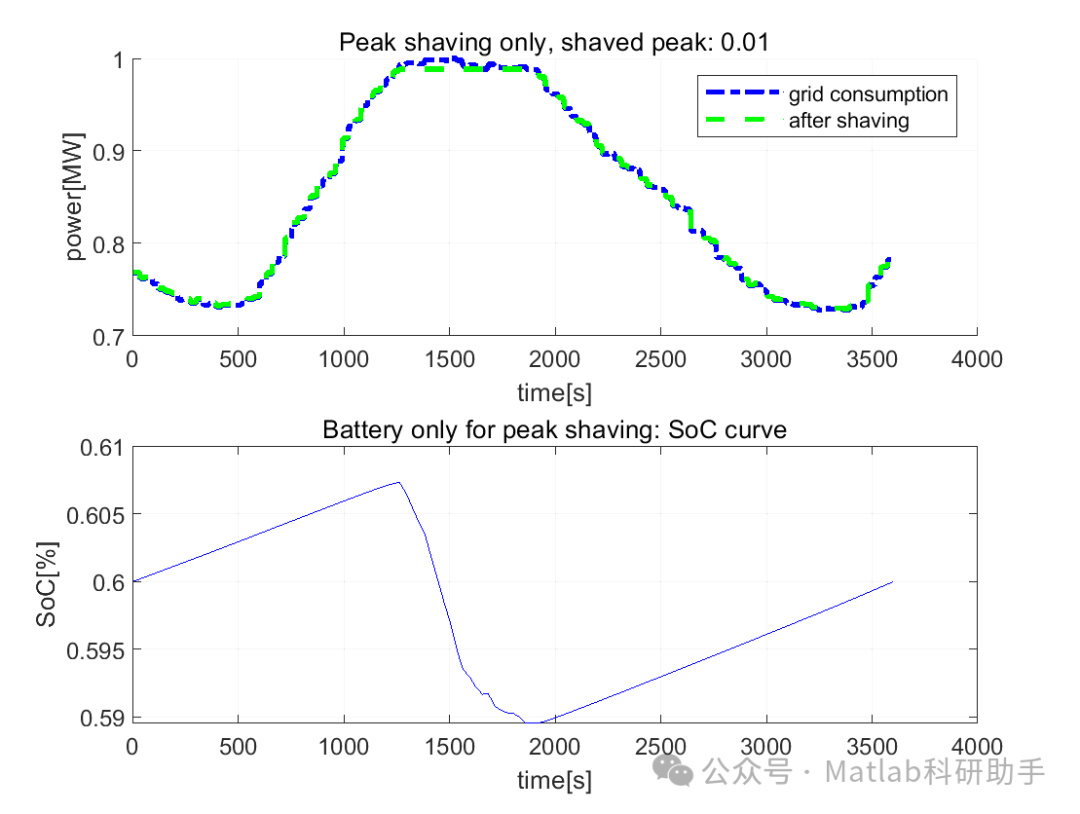
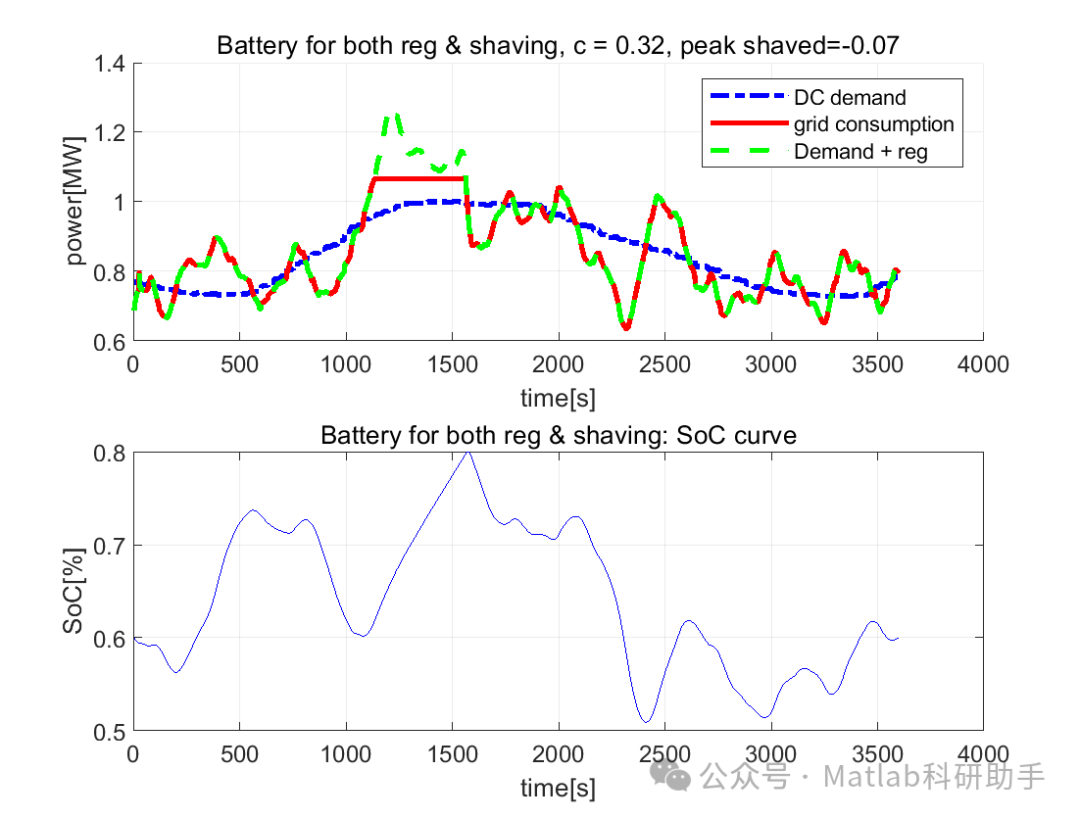
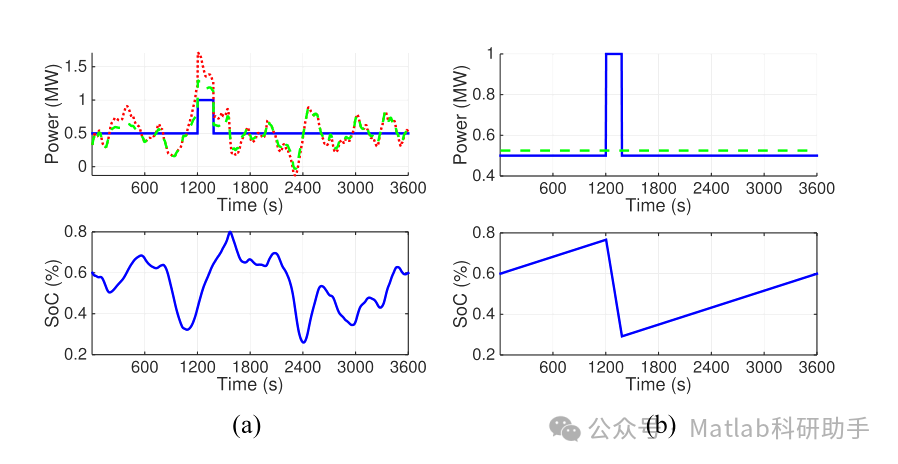
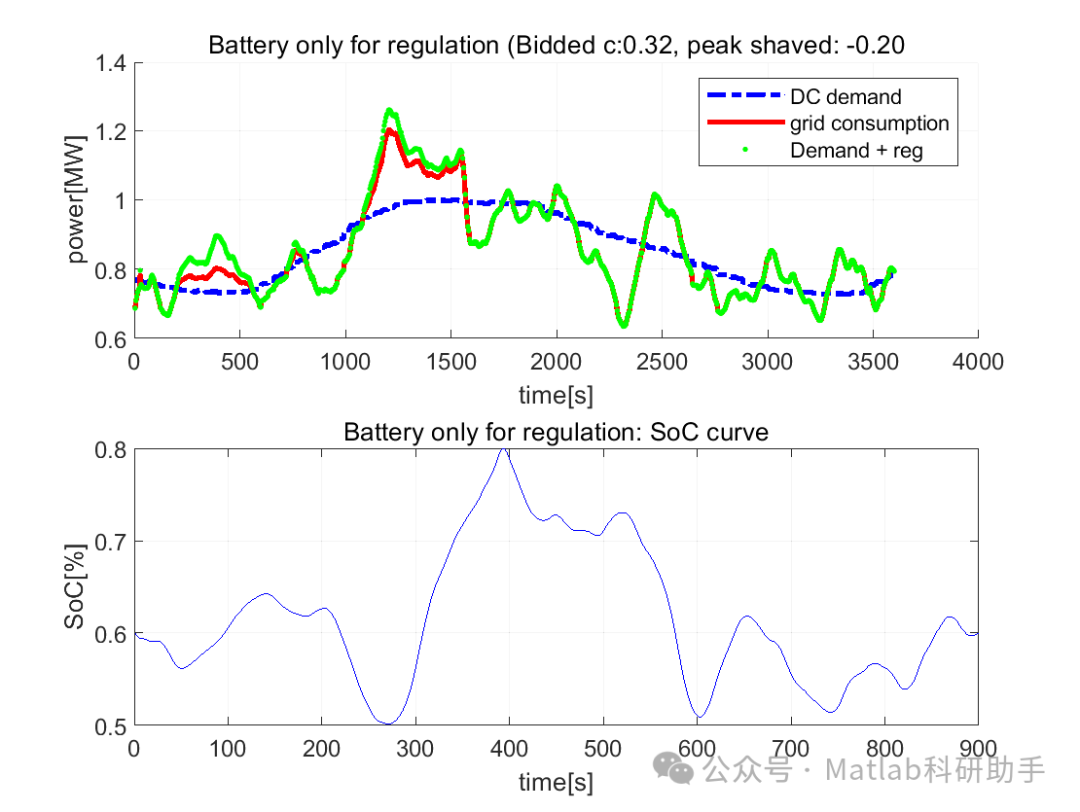
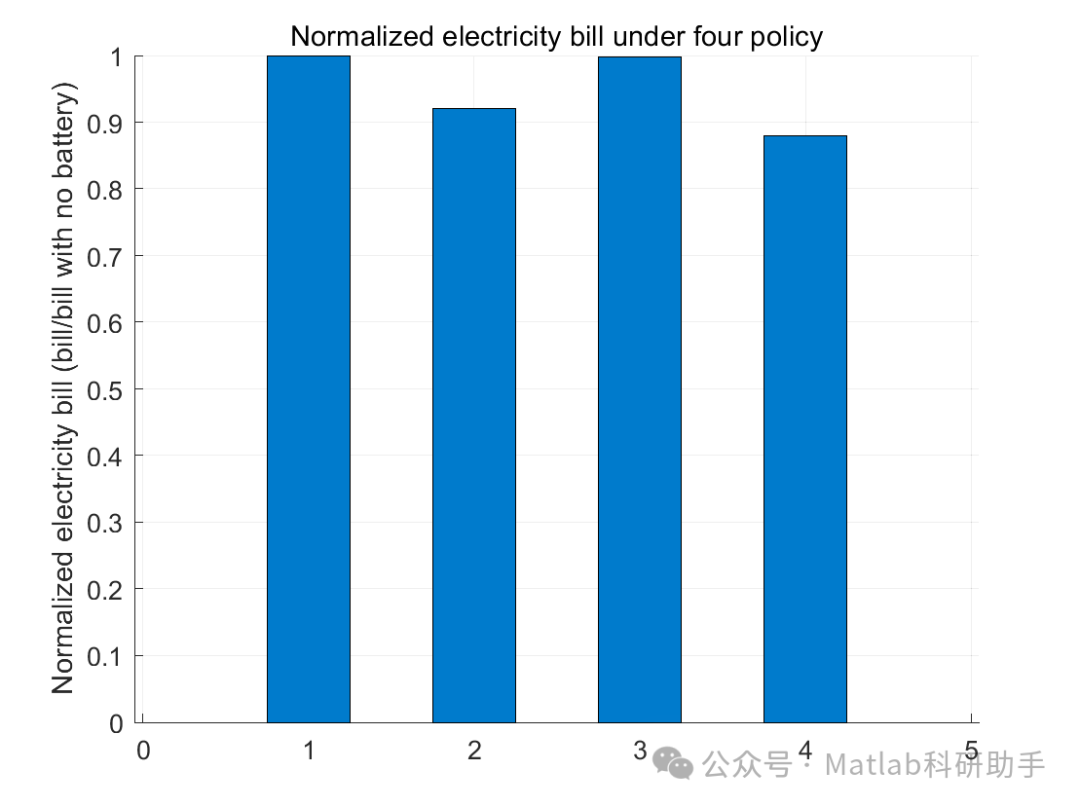
🔗 References
[1] Lu Longhui. Research on Modeling of Lithium-Ion Battery Energy Storage Systems and Their Impact on Grid Stability [D]. Hunan University, 2014.
[2] Wang Yue, Li Dan, Dong Xiao, et al. Research on Energy Storage Inverters Based on Automatic Code Generation in Matlab [J]. Power Electronics Technology, 2014, 48(5):3. DOI:10.3969/j.issn.1000-100X.2014.05.001.
[3] Zhang Xiaojuan. Research on Control Strategies for Energy Storage Stations in User-Side Grid Load Peak Shaving [D]. Shaanxi University of Science and Technology, 2013. DOI:10.7666/d.Y2308022.
📣 Partial Code
🎈 Some theoretical references are from online literature; please contact the author for removal if there is any infringement.
👇 Follow me to receive a wealth of Matlab e-books and mathematical modeling materials
🏆 Our team specializes in guiding customized Matlab simulations in various research fields to support your research dreams:
🌈 Various intelligent optimization algorithm improvements and applications
Production scheduling, economic scheduling, assembly line scheduling, charging optimization, workshop scheduling, departure optimization, reservoir scheduling, 3D packing, logistics site selection, cargo location optimization, bus scheduling optimization, charging pile layout optimization, workshop layout optimization, container ship loading optimization, pump combination optimization, medical resource allocation optimization, facility layout optimization, visual domain base station and drone site selection optimization, knapsack problem, wind farm layout, time slot allocation optimization, optimal distribution of distributed generation units, multi-stage pipeline maintenance, factory-center-demand point three-level site selection problem, emergency supply material distribution center site selection, base station site selection, road lamp post arrangement, hub node deployment, transmission line typhoon monitoring devices, container scheduling, unit optimization, investment portfolio optimization, cloud server combination optimization, antenna linear array distribution optimization, CVRP problem, VRPPD problem, multi-center VRP problem, multi-center multi-vehicle VRP problem, dynamic VRP problem, two-layer vehicle routing planning (2E-VRP), electric vehicle routing planning (EVRP), oil-electric hybrid vehicle routing planning, hybrid flow shop problem, order splitting scheduling problem, bus scheduling optimization problem, flight shuttle vehicle scheduling problem, site selection routing planning problem, port scheduling, port shore bridge scheduling, parking space allocation, airport flight scheduling, leak source localization
🌈 Time series, regression, classification, clustering, and dimensionality reduction in machine learning and deep learning
2.1 BP time series, regression prediction, and classification
2.2 ENS voice neural network time series, regression prediction, and classification
2.3 SVM/CNN-SVM/LSSVM/RVM support vector machine series time series, regression prediction, and classification
2.4 CNN|TCN|GCN convolutional neural network series time series, regression prediction, and classification
2.5 ELM/KELM/RELM/DELM extreme learning machine series time series, regression prediction, and classification
2.6 GRU/Bi-GRU/CNN-GRU/CNN-BiGRU gated neural network time series, regression prediction, and classification
2.7 Elman recurrent neural network time series, regression prediction, and classification
2.8 LSTM/BiLSTM/CNN-LSTM/CNN-BiLSTM long short-term memory neural network series time series, regression prediction, and classification
2.9 RBF radial basis function neural network time series, regression prediction, and classification
2.10 DBN deep belief network time series, regression prediction, and classification
2.11 FNN fuzzy neural network time series, regression prediction
2.12 RF random forest time series, regression prediction, and classification
2.13 BLS broad learning system time series, regression prediction, and classification
2.14 PNN pulse neural network classification
2.15 Fuzzy wavelet neural network prediction and classification
2.16 Time series, regression prediction, and classification
2.17 Time series, regression prediction, and classification
2.18 XGBOOST ensemble learning time series, regression prediction, and classification
2.19 Transform various combinations of time series, regression prediction, and classification
Covering wind power prediction, solar power prediction, battery life prediction, radiation source identification, traffic flow prediction, load forecasting, stock price prediction, PM2.5 concentration prediction, battery health state prediction, electricity consumption prediction, water optical parameter inversion, NLOS signal identification, precise prediction of subway stops, transformer fault diagnosis
🌈 In image processing
Image recognition, image segmentation, image detection, image hiding, image registration, image stitching, image fusion, image enhancement, image compressed sensing
🌈 In path planning
Traveling salesman problem (TSP), vehicle routing problem (VRP, MVRP, CVRP, VRPTW, etc.), three-dimensional path planning for drones, drone collaboration, drone formation, robot path planning, grid map path planning, multimodal transport problems, electric vehicle routing planning (EVRP), two-layer vehicle routing planning (2E-VRP), oil-electric hybrid vehicle routing planning, ship trajectory planning, full path planning, warehouse patrol
🌈 In drone applications
Drone path planning, drone control, drone formation, drone collaboration, drone task allocation, online optimization of safe communication trajectories for drones, vehicle-coordinated drone path planning
🌈 In communication
Sensor deployment optimization, communication protocol optimization, routing optimization, target localization optimization, Dv-Hop localization optimization, Leach protocol optimization, WSN coverage optimization, multicast optimization, RSSI localization optimization, underwater communication, communication upload and download allocation
🌈 In signal processing
Signal recognition, signal encryption, signal denoising, signal enhancement, radar signal processing, signal watermark embedding and extraction, electromyography signals, electroencephalography signals, signal timing optimization, electrocardiogram signals, DOA estimation, encoding and decoding, variational mode decomposition, pipeline leakage, filters, digital signal processing + transmission + analysis + denoising, digital signal modulation, bit error rate, signal estimation, DTMF, signal detection
🌈 In power systems
Microgrid optimization, reactive power optimization, distribution network reconstruction, energy storage configuration, orderly charging, MPPT optimization, household electricity
🌈 In cellular automata
Traffic flow, crowd evacuation, virus spread, crystal growth, metal corrosion
🌈 In radar
Kalman filter tracking, trajectory association, trajectory fusion, SOC estimation, array optimization, NLOS identification
🌈 In workshop scheduling
Zero-wait flow shop scheduling problem (NWFSP), permutation flow shop scheduling problem (PFSP), hybrid flow shop scheduling problem (HFSP), zero idle flow shop scheduling problem (NIFSP), distributed permutation flow shop scheduling problem (DPFSP), blocking flow shop scheduling problem (BFSP)
👇